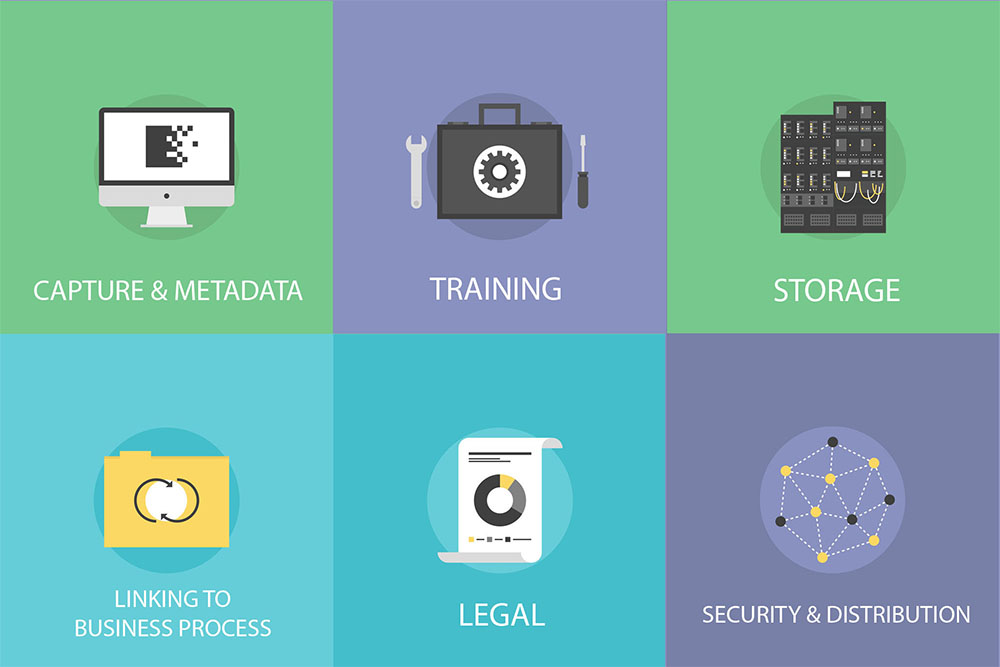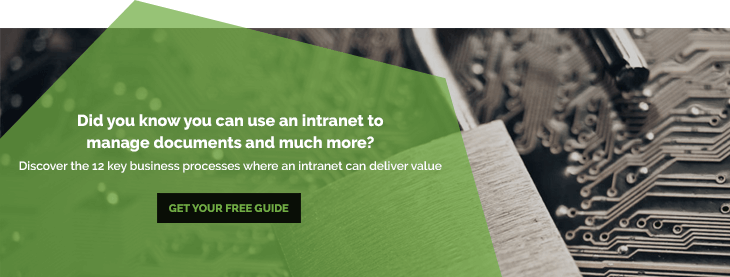Updated: 4th January 2024
Document Management Solutions provide organisations with the ability to convert, store and share a variety of digital documents within a network. This process enables corporate managers to reduce workload by minimizing the use of papers.
According to various sources such as Gartner Group and Laserfiche, 7.5% of all the documents get lost. Furthermore, 90% of these documents are shuffled, which leads to lost time. Interestingly, professionals spend 50% of their time looking for files but only 5% to 15% of their time reading the required information.
Taking into account these statistics, consider a scenario where 500 hours are consumed in retrieving the information while only one fifth of that time is spent in reading the actual content. This scenario does not include 7.5% of the documents that will never be found again.

Types of Document Management Software
As with most technologies, document management systems range in size and scope from smaller, standalone systems to part of larger, enterprise scale platforms with much more functionality. In fact, while document management is still recognized and utilized independently, it is also a common component found within intranet solutions.
Here’s a typical example of where intranets can assist.
| John orders a new business card by completing a paper form and sends it in the internal mail. It goes to his manager who approves it and she sends the form to the Central Services team. There, Marie copies the contents of the form into an email and sends it to the business card supplier. She copies in her colleague who adds the details to a spreadsheet so it can be costed back to John’s department. |
Duplicated effort, the risk of mistakes, the ability to lose the form, lack of speed, the waste of paper and the inability to derive data from the process make this highly inefficient.
The intranet goes beyond a standard alone document management system, by not only replacing inefficiency and wasted effort with a simple custom online form document, but allowing administrators to create associated workflows to automate the process. This means forms go to the right people based on the information that has been input and the specified business rules.
Data outputs for managing and reporting purposes can also be derived which can help increase visibility where needed. Now everybody can get on with the more interesting aspects of their roles.
For more information on how you can improve business processes using an intranet and create a high performance culture, read the intranet business processes eBook.
Key Points to Remember
Since the development of document management systems, experts agree that the rules of managing these systems have remained the same. Surprisingly, the best practices for document management implementation in 80’s are still relevant even after the rapid advancement in technology.

Here are a few of the most important points to remember when implementing document management systems:
Capture a Variety of Files
A good document management system is able to capture a variety of file types. Before implementation, decision makers should realize that their system is able to recognize images from scanned documents and multifunction printing tools. Additionally, they should check to see if their vendor provides optical character recognition capabilities that can identify text in the documents.
Nowadays, vendors may also offer optical mark recognition to capture the values in check-boxes. Nevertheless, managers should avoid document management solutions which support limited file types.
When Microsoft introduced the new version of doc files in docx format, they quickly realized that some well known document management systems did not offer the capability to recognize such a basic format. For companies, it quickly became a nuisance that their latest software had suddenly become limited. Therefore, decision makers should always trust vendors who are able to deliver the latest technology whenever it becomes available.
Consider Potential Legal Issues
Although managers may not put emphasis on the legalities of documents, which are captured by their systems, but such legal issues can play an important role in a future dispute. Unlike the web where rulings are often based on International laws making legal decisions a complicated affair, disputes arising from the use of the documents by a document management system are regulated and can result in strict penalties.
To avoid making costly mistakes, every manager should review the rules explained by organizations such as AIIM (Association for Information & Management) and ARMA (Association of Records). In Australia, use of such information is governed by the rules of RMAA (Records Management Association of Australia). Australian companies can also get free legal help from National Archives of Australia.
While, it may be difficult for managers to review the entire set of rulings therefore the objective of such entities is to provide legal support wherever possible. Accordingly, managers must play it safe by reviewing the rules in conflicting situations.
Automatically Detect & Store Metadata
Whenever the document management solution captures a file, it should detect and store the Metadata of that particular document. The Metadata is a type of heading or a title that provides a short description of the captured document. This ensures employees can later easily retrieve documents by searching for the keywords specified in the Metadata.
Modern systems are equipped with optical character recognition that can automatically identify the Metadata in the scanned images. Additionally, administrators can also prompt the user to provide a descriptive keyword that allows employees to search the required document.
Implement Policies to Create Trust
When managing sensitive documents, trust has an important part to play in providing confidence to employees. Since the introduction of electronic documents, managers should ensure that their workers are made aware of legal policies and understand the procedures on how to handle critical information. The implementation of such policies will automatically create trust within the organization by allowing employees to decide where to get help, if needed.
In this regard, managers of several large organizations lack judgment by creating a sole disclaimer, which automatically pop ups in front of the user before opening the document management system. Such disclaimers provide information on the legalities of using private information. Although it is among the best practices of managing documents, but administrators forget that most employees never read those policies.
Such practices may help with the legal proceedings but it will also create unnecessary hardships for employees, in case of future legal proceedings. Therefore, it may be better to insert two or three lines in plain English reminding employees to use good judgment when confused. Such a text can be accompanied by legal disclaimers to prevent the company and its employees in the court of law. A combination of simple instruction along with a legal disclaimer can help organizations fulfill their duties.
Similarly, managers should encourage employees to use their instinct in making decisions while employees should immediately contact higher authorities to prevent any misuse.
Review Storage Capacity
Of all the characteristics of an efficient document management software, good storage practices are central to the success of a company. Due to the vast quantities of data that a document management system can store, it becomes necessary to periodically review the storage capacity. Managers should decide on what is important to store and what information should be archived. At the time, it may also become necessary to destroy certain documents. The periodic review will allow the company to organize its database.
Modern document management systems allow users to create a hierarchy by assigning priority parameters to each document. Actually, hierarchical storage management is used by many companies to categorize documents. These hierarchical storage management capabilities allow companies to transfer documents from the high cost hard-disk drives to low cost optical drives.
This hierarchical process uses artificial intelligence to transfer data from hard-disk to optical drives, and vice versa. Such a process guarantees that the main servers of the document management system only store the relevant data. In fact, the process is very similar to cleaning the registry of personal computers and deleting unnecessary files from recycle bin.

Distribution & Security is Imperative
According to the law, users of document management software should understand that the distribution of any document is regulated by strict laws. For example, the original document should never be distributed. Instead, validation and quality endorsed applications should be used to circulate any copy of the original. It is important because only the original documents are accepted as a legitimate source of information in the court of law. The certified copies only ensure that the copy of the document is a reliable alternate of the original, outside the courtrooms.
Administrators can also provide additional security measures by distributing read-only content, wherever applicable. Portable document format (PDF) is the one of the most common methods of digital document distribution, which allows administrators to set the security parameters. Such rights management modules allow limited access to the other users. The Health Insurance Portability and Accountability Act is an example of ruling on the distribution and security of documents.
Provide Necessary Training
Often, managers overlook the importance of training their workers to utilize the several automated functions embedded in a document management system. Even successful companies sometimes are reluctant to provide the necessary training to their workers.
The end result is the availability of very efficient platform, but no one to use it. For example, modern management systems come with various advanced features such as workflow automation, allowing management to create a rule for the automatic delivery of the document to several users in a hierarchy. Such workflow can help to pass an invoice to different users in a hierarchical chain where each user needs to review and sign the particular invoice before the final release of finds by the accounting department.
Experts think that the lack of training is the most crucial factors in the failure to implement large scale document management systems.
Linking Records to Business Process
The purpose of document management is to automate, streamline and improve business processes across the organisation by creating access to the required document when needed. Before implementing such a solution, managers should be able to link the types of records to a particular business process.
Without defining these relationships, it will become difficult for different users to relate a document to a certain task. For example, whenever a new customer uploads the scanned documents to a system, it may be the ‘new accounts’ department responsible for ensuring the processing of such a document. If someone else has access to that particular document then the person from the other department should realize that they cannot destroy or change the location of the document without prior consent from the ‘new accounts’ department.
Consequently, it may be the managers of ‘new accounts’ department who is responsible for deciding which records of applicants are to be destroyed. Simply, no one else should try to evaluate the eventual outcome of the documents for new applicants. In this case, the scanned documents from potential new customers are relegated to ‘new accounts’ department therefore linking that particular business process with a designated department. Creating such process will streamline the work flow.
According to AIIM, Association for Information & Image Management revealed many interesting factors that further emphasize the need to implement a reliable document management solution. Here are the top three:
- 39% describe their email management as “chaotic”, including the largest organizations. 55% agree that email is their big untagged, ungoverned, high-risk content type.
- Poor content management practices result in taking too long to find content (62%), duplicated efforts (52%) and insufficient re-use (46%).
- 49% also report too many round-robin emails and 40% cite unnecessary printing.
These statistics can be interpreted to suggest that managers of large scale organizations are still finding it a challenge to implement best practices for document management software.
Next Steps
Document management solutions are highly effective in reducing hundreds of hours that were wasted in the distribution, locating and managing of paper files.
Are your document management processes slowing you down?
In this digital age, where there are several solutions on the market, there is no excuse for having poor document management processes.
Download our free guide, and discover how you can use an intranet to improve not only your document management processes, but 11 other important business processes!
